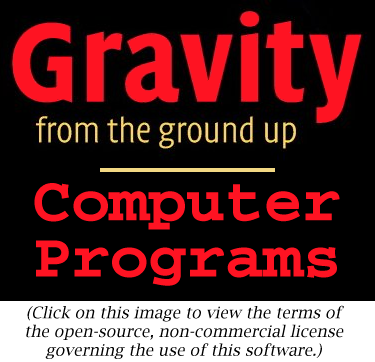|
Programs
listed in the
order of their appearance in the book:
CannonTrajectory
(Ch. 1)
EarthOrbit
(Ch. 4)
Orbit
(Ch. 4)
SphereGravity
(Ch. 4)
Atmosphere
(Ch. 7)
Star
(Ch. 8)
Random
(Ch. 8)
Planck
(Ch. 10)
Binary
(Ch. 13)
MercPert
(Ch. 13)
Multiple
(Ch. 13)
Neutron
(Ch. 20)
RelativisticOrbit
(Ch. 21)
|
Alphabetical
list and
short descriptions of all the programs
-
Atmosphere.
Computes the structure of a planetary atmosphere, like that of the
Earth.
It implements the condition of neutral-buoyancy, called the equation of
hydrostatic equilibrium. Introduced in Chapter 7.
- Binary.
Computes the motion of two stars (or other bodies) in a binary system,
where they orbit under their mutual gravitational attraction. It can be
used to describe binary stars or to discover the effect of Jupiter on
the
Sun's position as it orbits the Sun. Introduced in Chapter 13, this
program
is further extended by Multiple,
which allows any number of bodies to interact.
- CannonTrajectory.
The first program for the book, this computes the most elementary
motion
problem in gravitation: the trajectory of a projectile fired for short
distances along the ground. It forms the basis for all the more
sophisticated
motion programs, such as EarthOrbit,
Orbit
and their descendants. Introduced in Chapter 1.
- EarthOrbit.
Extends CannonTrajectory
to compute the motion of a projectile fired from near the Earth's
surface,
but with a sufficient speed to get it into orbit. In CannonTrajectory
the Earth is flat; here it is a sphere! Introduced in Chapter 4.
- MercPert.
Computes the motion of a small planet like Mercury if it is in a solar
system around a star like ours but with a planet more massive than
Jupiter
and very much nearer the Sun. Exhibits fascinating behaviors: capture
of
Mercury by the Sun or the large planet, slingshot effects, expulsion of
Mercury from the system. Discussed in Chapter 13; extended from Orbit.
|
|
Programs
grouped by subject:
Equations of motion
CannonTrajectory
(Ch. 1)
EarthOrbit
(Ch. 4)
Orbit
(Ch. 4)
Binary
(Ch. 13)
MercPert
(Ch. 13)
Multiple
(Ch. 13)
RelativisticOrbit
(Ch. 21)
Structure of stars and
atmospheres
Atmosphere
(Ch. 7)
Star
(Ch. 8)
Neutron
(Ch. 20)
Verifying mathematical theorems
Orbit
(Ch. 4)
SphereGravity
(Ch. 4)
Random
(Ch. 8)
Planck
(Ch. 10)
|
-
Multiple.
Computes the orbits of any number of bodies under their mutual
gravitational
attractions in Newtonian gravity. Can be used to simulate three-body
interactions,
such as capture formation, but can also be used for more bodies and
more
complicated systems. Discussed in Chapter 13; extended from Binary.
- Neutron.
Computes the structure of a neutron star using the neutral buoyancy
equation
(equation of hydrostatic equilibrium) in full general relativity, and
using
a semi-realistic equation of state. Introduced in Chapter 20.
- Orbit.
Calculates
the orbit of a planet around a central star, as introduced in Chapter
4.
Can be used to show that orbits in Newtonian gravity are closed
ellipses.
This is the main motion program, introducing accuracy-improving
techniques
like automatic time-step halving and the predictor-corrector. Binary,
MercPert,
Multiple,
and
RelativisticOrbit
are all derived. It is based on EarthOrbit.
- Planck.
Computes the Planck function, which describes the spectrum of black
body
radiation, and finds the location of its peak and the area under the
curve.
These are used for estimating the color of a radiating black body and
its
luminosity. Introduced in Chapter 10.
- Random.
Computes the expected result of a random walk in three dimensions by
averaging
over many random walks, and plots the mean net distance traveled
against
the number of steps. Introduced in Chapter 8.
- RelativisticOrbit.
Computes the orbit of a planet around a black hole or neutron star,
using
the equation of motion appropriate to full general relativity, worked
out
in Chapter 21. Derived from Orbit.
- SphereGravity.
Shows that the gravitational field outside a sphere is the same as the
field that would be produced by a point particle of the same mass at
the
center of the sphere, and that the gravitational acceleration
everywhere
inside a hollow spherical shell is zero. This verifies numerically a
theorem
originally proved by Newton. Introduced in Chapter 4.
- Star.
Computes
the structure of a spherical star in Newtonian gravity, as discussed in
Chapter 8. It uses a polytropic equation of state (in which the density
and pressure are related by a power law). Derived from Atmosphere.
|

